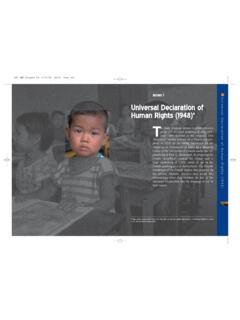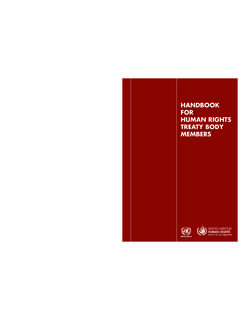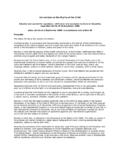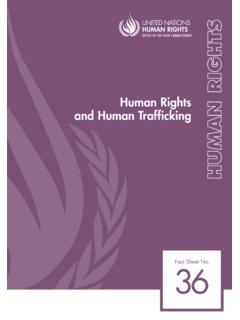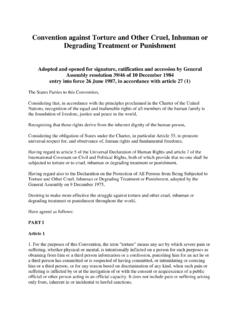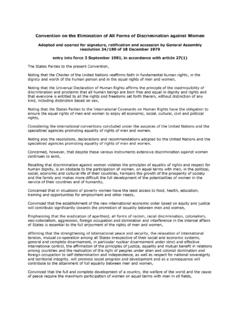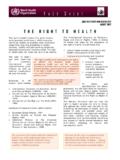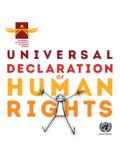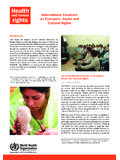Transcription of The Right to Health - OHCHR
1 World Health Organization Office of the United Nations High Commissioner for Human rights The Right to Health Fact Sheet No. 31. NOTE. The designations employed and the presentation of the material in this publication do not imply the expression of any opinion whatsoever on the part of the Secretariat of the United Nations or the World Health Organization concerning the legal status of any country, territory, city or area, or of its authorities, or concerning the delimitation of its frontiers or boundaries. Material contained in this publication may be freely quoted provided credit is given and a copy of the publication containing the reprinted material is sent to the Office of the United Nations High Commissioner for Human rights , Palais des Nations, 8-14 avenue de la Paix, CH-1211 Geneva 10, Switzerland and to WHO Press, World Health Organization, 20 avenue Appia, CH-1211 Geneva 27, Switzerland.
2 Ii CONTENTS. Page iv 1. III. WHAT IS THE Right TO Health ?.. 3. I A. Key aspects of the Right to 3. B. Common misconceptions about the Right to 5. C. The link between the Right to Health and other human 6. D. How does the principle of non-discrimination apply to the Right to Health ?.. 7. E. The Right to Health in international human rights 9. III. HOW DOES THE Right TO Health APPLY TO SPECIFIC GROUPS? 11. A. 12. B. Children and 14. C. Persons with 16. D. 18. E. Persons living with 20. III. OBLIGATIONS ON STATES AND RESPONSIBILITIES OF OTHERS. TOWARDS THE Right TO 22. A. General 22. Progressive realization Taking steps to realize the Right to Health Core minimum obligation B. Three types of 25. The obligation to respect The obligation to protect The obligation to fulfil iii Page C.
3 Do others have responsibilities too?.. 28. United Nations bodies and specialized agencies The private sector IV. MONITORING THE Right TO Health AND HOLDING STATES 31. A. Accountability and monitoring at the national 31. B. Accountability at the regional 35. C. International 36. Annex: Selected international instruments and other documents related to the Right to 41. ABBREVIATIONS. aids Acquired immunodeficiency syndrome HIV Human immunodeficiency virus NHRI National human rights institution OHCHR Office of the United Nations High Commissioner for Human rights UNICEF United Nations Children's Fund WHO World Health Organization iv Introduction As human beings, our Health and the Health of those we care about is a matter of daily concern. Regardless of our age, gender, socio-economic or ethnic background, we consider our Health to be our most basic and essential asset.
4 Ill Health , on the other hand, can keep us from going to school or to work, from attending to our family responsibilities or from participating fully in the activities of our community. By the same token, we are willing to make many sacrifices if only that would guarantee us and our families a longer and healthier life. In short, when we talk about well-being, Health is often what we have in mind. The Right to Health is a fundamental part of our human rights and of our understanding of a life in dignity. The Right to the enjoyment of the highest attainable standard of physical and mental Health , to give it its full name, is not new. Internationally, it was first articulated in the 1946 Constitution of the World Health Organization (WHO), whose preamble defines Health as a state of complete physical, mental and social well-being and not merely the absence of disease or infirmity.
5 The preamble further states that the enjoyment of the highest attainable standard of Health is one of the fundamental rights of every human being without distinction of race, religion, political belief, economic or social condition.. The 1948 Universal Declaration of Human rights also mentioned Health as part of the Right to an adequate standard of living (art. 25). The Right to Health was again recognized as a human Right in the 1966 International Covenant on Economic, Social and Cultural rights . Since then, other international human rights treaties have recognized or referred to the Right to Health or to elements of it, such as the Right to medical care. The Right to Health is relevant to all States: every State has ratified at least one international human rights treaty recognizing the Right to Health .
6 Moreover, States have committed themselves to protecting this Right through international declarations, domestic legislation and policies, and at international conferences. In recent years, increasing attention has been paid to the Right to the highest attainable standard of Health , for instance by human rights treaty- monitoring bodies, by WHO and by the Commission on Human rights (now replaced by the Human rights Council), which in 2002 created the mandate of Special Rapporteur on the Right of everyone to the highest attainable standard of physical and mental Health . These initiatives have helped clarify the nature of the Right to Health and how it can be achieved.. This fact sheet aims to shed light on the Right to Health in international human rights law as it currently stands, amidst the plethora of initiatives and proposals as to what the Right to Health may or should be.
7 Consequently, it does not purport to provide an exhaustive list of relevant issues or to identify specific standards in relation to them. The fact sheet starts by explaining what the Right to Health is and illustrating its implications for specific individuals and groups, and then elaborates upon States' obligations with respect to the Right . It ends with an overview of national, regional and international accountability and monitoring mechanisms.. I. WHAT IS THE Right TO Health ? A. Key aspects of the Right to Health . The Right to Health is an inclusive Right . We frequently associate the Right to Health with access to Health care and the building of hospitals. This is correct, but the Right to Health extends further. It includes a wide range of factors that can help us lead a healthy life.
8 The Committee on Economic, Social and Cultural rights , the body responsible for monitoring the International Covenant on Economic, Social and Cultural rights , calls these the underlying determinants of Health . They include: Safe drinking water and adequate sanitation;. Safe food;. Adequate nutrition and housing;. Healthy working and environmental conditions;. Health -related education and information;. Gender equality. T. he Right to Health contains freedoms. These freedoms include the Right to be free from non-consensual medical treatment, such as medical experiments and research or forced sterilization, and to be free from torture and other cruel, inhuman or degrading treatment or punishment. The Right to Health contains entitlements. These entitlements include: The Right to a system of Health protection providing equality.
9 Of opportunity for everyone to enjoy the highest attainable level of Health ;. The Right to prevention, treatment and control of diseases;. Access to essential medicines;.. Many of these and other important characteristics of the Right to Health are clarified in general comment N 14 (2000) on the Right to Health , adopted by the Committee on Economic, Social and Cultural rights .. The Covenant was adopted by the United Nations General Assembly in its resolution 2200A (XXI) of 16 December 1966. It entered into force in 1976 and by 1 December 2007. had been ratified by 157 States.. Maternal, child and reproductive Health ;. Equal and timely access to basic Health services;. The provision of Health -related education and information;. Participation of the population in Health -related decision.
10 Making at the national and community levels. H. ealth services, goods and facilities must be provided to all without any discrimination. Non-discrimination is a key principle in human rights and is crucial to the enjoyment of the Right to the highest attainable standard of Health (see section on non-discrimination below). All services, goods and facilities must be available, accessible, acceptable and of good quality. Functioning public Health and Health -care facilities, goods . and services must be available in sufficient quantity within a State. They must be accessible physically (in safe reach for all sections . of the population, including children, adolescents, older persons, persons with disabilities and other vulnerable groups). as well as financially and on the basis of non-discrimination.


